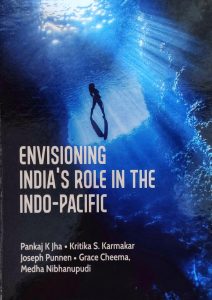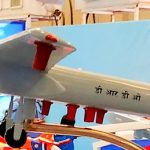
“The Indo-Pacific is both a place and an idea. It is the most globally connected region and the main highway for commerce and energy between Asia, Africa, Europe, Oceana, and the Americas. The most populous, dynamic, and consequential region in the world.”
—— Rory Medcalf
Indo-Pacific, the—-“Maritime Umbrella” of Asia is regarded as the centre of gravity, both for its economic and demographic potential as well as security challenges, not only for Asia but also for the rest of the world. The Indo-Pacific is emerging as the new and expanded theatre of great-power contestation where the interest of many stakeholders lies. The Indo-Pacific is an integrated region that combines the Indian Ocean and the Pacific Ocean, and the landmasses that surround them. It is an evolving concept replacing the earlier term “Asia-Pacific” which was narrow in nature covering only economic conception, rather than a security-related notion and does not include India as a full member. And the Indo-Pacific strategy provides India a central role, especially in the Indian Ocean Region (IOR) and in South Asia.
As the Indo-Pacific becomes the centre of global attention, multiple visions and strategies for the region have come up. This book has eight chapters that assess India’s role as a crucial player in the Indo-Pacific Region and its strategies to secure its national interests.
The first chapter of the book begins with India’s strategy towards Indo-Pacific centred around creating partnerships with other nations and considering China’s assertive role in the region. India has emphasized that its idea of Indo-Pacific stands for ‘free’, ‘open’, ‘inclusive’, ‘ASEAN Centrality’, and ‘unity.’ To address the region’s growing salience in global discourse, in 2019, India established a new division for the Indo-Pacific in its Ministry of External Affairs. An initiative like the Indo-Pacific Ocean’s Initiative (IPOI) focuses on partnership with ‘like-minded’ nations on connectivity, maritime security, capacity building, and resource sharing. India’s Indo-Pacific region largely covers India-ASEAN relations; East Asia Summit (EAS); Mekong-Ganga Cooperation (MGC); Ayeyawady–Chao Phraya–Mekong Economic Cooperation Strategy (ACMECS); Indian Ocean Rim Association (IORA); Asia Europe Meeting (ASEM) to promote economic cooperation, cultural ties and building strong strategic and security relationship with countries in Indo-Pacific region through continuous engagement at bilateral, regional and multilateral levels. Apart from economic and political initiatives, India has also joined a quasi-defence partnership which is known as QUAD (Quadrilateral Security Dialogue).
In the second- and third-chapter authors explains about the evolution of QUAD and its importance in the Indo-Pacific Region. After the initial failure of Quad in 2008, the new version of the Quad, also known as Quad 2.0 is an informal strategic dialogue with four members, namely, India, Japan, Australia, and the US to ensure an open, free, prosperous and inclusive Indo-Pacific region, signalling a counter to China’s growing influence. It is an opportunity for like-minded countries to collaborate on objectives of mutual interests of regional security, maritime cooperation, counter-terrorism, non-proliferation, connectivity, development, and engagement with ASEAN and other regional forums. In 2020 amid the COVID-19 pandemic outbreak, three additional Indo-Pacific powers: New Zealand, South Korea, and Vietnam participated in the virtual meeting with the Quad members named as Quad-Plus to synergize their efforts to fight against the spread of coronavirus and more importantly, ways to get the global economy back on track without significant setback.
The Authors state that Quad plus requires to include more regional powers like Indonesia, Singapore, and the Philippines because of their geographic vantage location and it is important for India to engage with regional powers to safeguard its interests in the Indo-Pacific.
In Chapter four the book outlines the Indo-Pacific Oceans Initiative (IPOI) which seeks to enable India’s proactive and constructive role in the region. IPOI is in line with Sustainable Development Goal-14 which aims to conserve and sustainably use the maritime domain. IPOI is anchored on India’s ‘Act East’ policies. It also draws similarities between the ASEAN Outlook and IPOI through which both nations will work towards common goals of trade, connectivity, maritime security, maritime ecology, capacity building, and maritime transport to achieve shared security, prosperity, and growth for all in the region.
The fifth chapter deals with India’s Foreign Policy Perspective in the Indo-Pacific. India and ASEAN has adopted the plan of action for 2021-25 that envisions greater cooperation in areas ranging from trade to maritime security and counter-terrorism. It also includes agreement on joint exercises and activities, to improve the defence capabilities to counter challenges arising from terrorism, cyber security, peacekeeping operations, disaster relief, and humanitarian assistance to provide ‘freedom of navigation and respect international law of UNCLOS,1982 for dispute resolution.
India’s Indo-Pacific strategy calls for a free, open, and inclusive order based upon respect for sovereignty and the territorial integrity of all nations. India’s goals are clear, it is strictly against an “alliance of containment” against China and will actively engage in collaborations and partnerships with democratic states. India has been playing a crucial role in assisting many nations of South Asia and the Indian Ocean by providing security like India-Japan Asia-Africa Growth Corridor. India is expanding its relations with small islands i.e., Pacific Island nations which are rich in natural resources like LNG (Liquefied Natural Gas) and geo-strategically part of the Indo-Pacific region by offering them Line of Credit for projects like solar power, energy sources, climate change, and giving assistance to them capacity building in disaster management, Climate Early Warning System and health sector.
China’s increasing presence close to India’s territorial waters, unsustainable projects in neighbours are a direct threat to India’s position as the main security provider and regional power and sea lanes of communication (SLOCs) which are critical for the movement of goods and people in times of both peace and conflict.
The sixth and seventh chapter of the book gives detailed understanding about India’s multilateral, plurilateral talks and economic, diplomatic and military engagement with ASEAN nations and other Indo-Pacific partners in the Indo-Pacific region to enhance cooperation in confronting terrorism, piracy, drugs trafficking, illegal and arms trading, maritime pollution and climate change in order to preserve a stable balance of power in the region. The Indian Navy regularly conducts exercises with friendly navies such as Malabar (Indian-US naval exercises), PASSEX (India-US joint military exercise), Tiger Triumph, Harimau Shakti (India-Malaysia joint military exercise), MILAN, SITMEX (India-Singapore-Thailand trilateral exercise) to promote interoperability between armed forces to tackle maritime threats by enhancing collaborations in Maritime Domain Awareness (MDA), training, capacity building of maritime forces, and joint activities to strengthen maritime security. Despite RCEP (Regional Comprehensive Economic Partnership) walkout, India remains committed to deepening trade relations with ASEAN nations through ASEAN-India Trade in Goods Agreement (AITGA) and bilateral agreement which is important for trade and economic cooperation.
India’s stance on the South China Sea is of a security maximizer rather than a power maximizer, seeking to support its partners in the region while also maintaining its position on non-intervention. But India’s main focus remains in the Indian Ocean region and in countering Chinese influence in its immediate neighbourhood first. India is a ‘net security provider’ and ‘first responder’ in the maritime neighbourhood which includes deployment of Humanitarian Assistance and Disaster Relief (HADR) operations and Non-combatant Evacuation Operations (NEO) to address natural disasters, non-traditional threats. In addition, amidst the COVID-19 pandemic, India under Mission Sagar provided medicines like hydroxychloroquine and paracetamol to SAARC countries as well as to Mauritius, Seychelles, the Caribbean, and Latin American countries. In the words of Minister of External Affairs Dr. S. Jaishankar, India’s foreign policy aims “to aspire to be a leading power, rather than just a balancing power”……
The authors have put down insightful recommendations towards the end of the book. It includes, viz. India should establish stronger relations with countries of the same democratic values like New Zealand and Canada to further invigorate its Indo-Pacific Policy. Bearing in mind the current COVID-19 pandemic, India should use this opportunity to collaborate with other nations and form an alliance who would help bolster India’s Indo-Pacific vision in the future and India could aid these smaller nations to build their health infrastructure. Most of the Free trade agreements are underutilized, due to the limited knowledge among Indian exporters. There is a need to create more awareness among Indian Exporters so that they use opportunities and support the Indian Economy. Smaller industries should also be encouraged. QUAD can work on a common intelligence network and also enhance the development of software for military encryption and support research to identify focus areas.
The Indo-Pacific construct has provided an opportunity for India to maximize its strategic interests while responding to changes in the security environment. This book is the in-depth work on India’s concerted actions in the Indo-Pacific region that will determine its evolution as a key player. It is a must-read book for anyone interested in understanding the dynamics of the India-Indo-Pacific connection. The simple narrative of the book outlines a vision of the Indo-Pacific region through India’s eyes. The authors end by urging India to explore untapped possibilities with its partners and address its own challenges and capability gaps.














